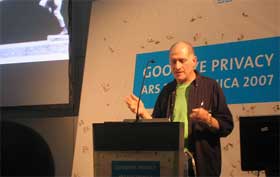 Yeah! The return of the ars electronica posts. To be honest with you, this is going to be a messy time on wmmna. There are still tons of stories to write about Conflux, my little trips to Chelsea, to Beijing and there are a few more reports in store.
Yeah! The return of the ars electronica posts. To be honest with you, this is going to be a messy time on wmmna. There are still tons of stories to write about Conflux, my little trips to Chelsea, to Beijing and there are a few more reports in store.
Right, here’s the notes i took during the talk given by Bernie Lubell as a winner of the Interactive Art category.
Erkki Huhtamo, member of the jury this year, introduced the forum by explaining how people had been complaining that the interactive component of the winning works had not always been obvious over the past few years. With the creation of the Hybrid category, the focus of the Interactive Art one is now on the role of human interacting with systems and networks.
There’s no electronics involved in Lubell`s installation, just wood and pneumatic components. Yet, the work charmed the whole ars electronica crowd (well, apart i guess from the usual bunch of Mr. Grumpies). It is interactivity without any pretension, just poetry and playfulness.
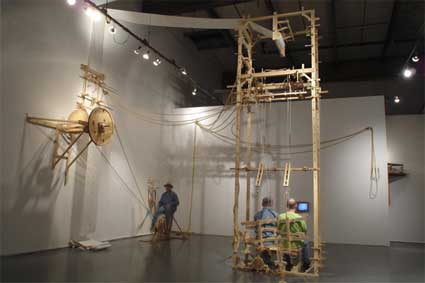
For Lubell, the winning work Conservation of Intimacy is all about having people physically involved, the body is part of the installation. The installation is just a stage where visitors are invited to perform their own play. The movements of a couple jumping and twisting on a wooden bench are transferred via air pressure to balls located in the adjacent room. It is made as a fully cooperative work, in fact, the bench/balls part works better when there are two people side by side on the bench.
At the same time, their movements are transferred from the drawing stylus mounted high on the wall opposite the bench onto a roll of paper that is, in turn, unspooled by a third person riding a stationary bike. There is a feedback loop between what everyone is doing and the record of it.
The elaborate wood construction is modeled on a computer; human beings assume the role of the processors.
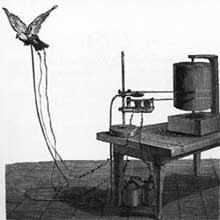 The installation was inspired by the physiological experiments Etienne Jules Marey conducted in the 19th century and is meant to expand Marey´s work into the field of intimacy.
The installation was inspired by the physiological experiments Etienne Jules Marey conducted in the 19th century and is meant to expand Marey´s work into the field of intimacy.
Marey is famous for his research on chronophotography. But before experimenting with photography, Marey was building all sorts of pneumatic systems to better understand and measure precisely body movements, from heart beats to the way a bird flies. For example, one of these systems measured the way lips were moving during speech and his research was fundamental for the field of medical imagery.
He was successful in selling a portable instrument called Sphygmographe to measure the pulse. He hooked up horses with pneumatic sensors to study how they run (a work which inspired Muybridge and had him prove that prove that Marey was right when he wrote that a galloping horse for a brief moment had all four hooves off the ground) or construct sophisticated apparatus that he attached to the wings of birds to measure their precise movements while they are flying.
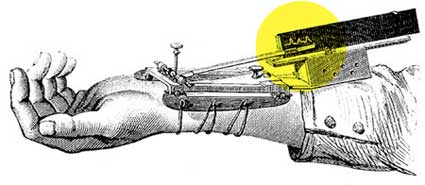 Marey’s Sphygmograph
Marey’s Sphygmograph
“Conservation of Intimacy� received an award for the way it combines artistic, scientific, technological and cultural aspects, and shows that interaction functions best when each individual protagonist takes the actions of the others into account: Intimacy as the essential component of social interaction.
The exhibition at the OK Centrum also showed another of Lubell´s works which i liked a lot. Cheek to Cheek allows you to dance with youself, well… “cheek to cheek”. You done a strange wooden helmet, sit on a stool and have to move about so that bladders beneath the seat transmit air to bladders pressed against your cheeks.
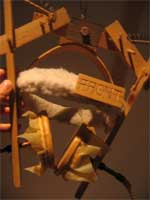
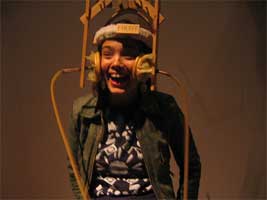
During his talk, he highlighted some of his installations. The most surprising one …and the Synapse Sweetly Singing have visitors crank themselves inside a coffin than use a network of tin-can telephones to communicate with other visitors in the gallery.
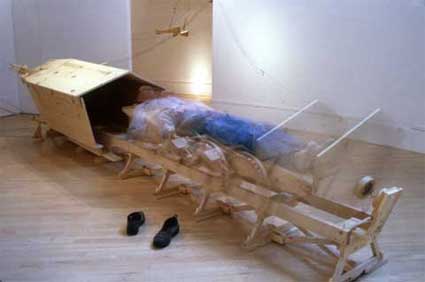
That guy rocks. He reminded me of Theo Jansen, an artist quietly doing his own thing without wondering whether it is cool, innovative, whether it fits in the art system or not.
